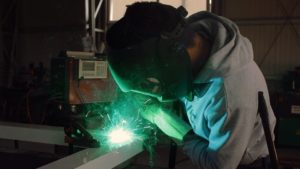
Hardfacing is a low cost welding process used to deposit wear-resistant materials onto metal components in order to extend their service life. The material applied is harder, erosion resistance, corrosion resistance and ductility compare to the base metal.
While hardfacing is primarily used to restore worn parts to usable conditions or repair previously deteriorated parts, it can also be applied to new metal components as a value-added feature before they are placed into service.
Some common benefits of hardfacing (or hardsufacing) include:
- Reduced overall costs
- Fewer replacement parts required
- Use of relatively cheaper base metal
- Reduced downtime, which increases operating efficiency
Let’s look at some common procedures used to apply hardfacing so that you can opt for the process that’s right for your application.
Gas Metal Arc Welding (GMAW)
GMAW, also commonly know MIG (Metal Inert Gas welding) is an automatic or semi-automatic welding process in which an arc forms between a continuously fed MIG wire electrode and workpiece metal. This heats the metal and causes it to melt and join. Shielding gas is also fed through a welding gun to shield the entire process from atmospheric contamination.
GMAW process provides high quality weld and allows the material to be deposited a lot faster compared to TIG or SMAW processes. What’s more, it can be used with a range of alloys and can be operated in several ways.
Submerged Arc Welding (SAW)
Similar to GMAW, SAW also involves formation of an arc between a workpiece and a continuously-fed electrode. However, in this case, the process is shielded from atmospheric contamination by being “submerged” under a fusible flux that consists of manganese oxide, lime, silica, calcium fluoride and other compounds.
The process applies slag and protective gases to the weld pool, and the excess flux is recycled through a flux feed hopper.
SAW creates high quality welds with minimal fumes, average operational skills and high metal deposition rates.
Gas Tungsten Arc Welding (GTAW)
Also called TIG (tungsten inert gas welding), GTAW differs from the other welding processes in the fact that it produces an arc between a non-consumable electrode and a workpiece. A shielding gas protects the weld area from contamination.
GTAW is versatile and can be welded in all positions, compared to GMAW and SAW that can only be welded in vertical and horizontal positions, respectively.
Because GTAW produces unmatched high quality welds, the process is used in critical applications in the chemical, aerospace, and nuclear industries.
If you need help with custom welding services, get in touch with our certified welders in Wasilla, Alaska. They can help you determine the right hardfacing process for your applications.
Get in touch with us today for more information.

